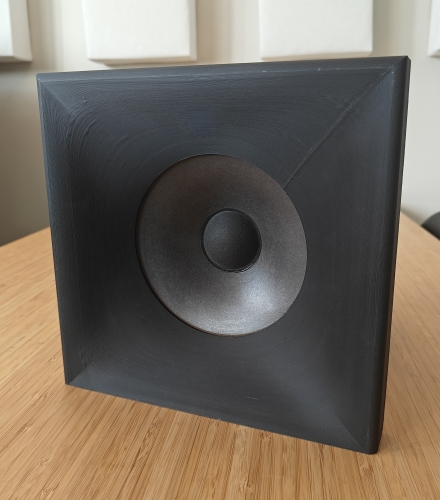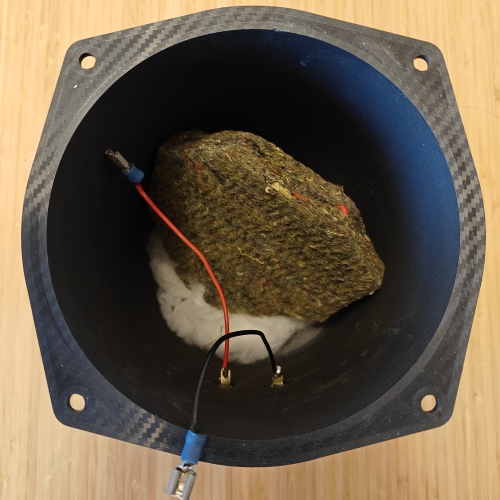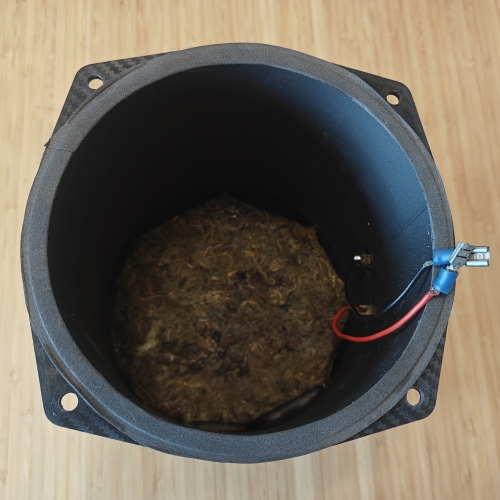Constant Directivity Midrange Waveguide, put your dedicated midrange driver in a waveguide
Why Midrange Waveguide
The purpose of a waveguide, here a midrange waveguide, is not to significantly load the device but to control its radiation, for example by adding à little bit of Directivity Control extension or, even more important, to have an identical directivity when crossing it to a high frequency horn, like a X-Shape 25 with a 1" compression driver at the top.
When we want to cross horns between one another, we will not cut the high frequency horn where it begins to lose control, like we would do when crossing to some woofer in direct radiation, but higher, when it is still in full constant directivity behavior, so it’s the same for the midrange waveguide, we will cut it when it is in Constant Directivity behavior.
About a horn or waveguide on a midrange driver, we would use it in two cases :
-
In association of our Tweeter Waveguide in passive crossover: Our midrange waveguide allows the mid-woofer to be placed closer to the tweeter. This reduces the distance between the drivers and also allow a perfect match at the crossover section, making it a perfect companion for our PureShape tweeter waveguide.
-
Waveguide tinier as the HF horn: When we want to associated a woofer/midrange driver smaller than the HF horn we need to create a directivity control equal to the upper horn in order to have a perfect directivity match at crossover frequency. When the woofer/midrange driver is arround the same size of the horn with which he is associated it’s not necessary to add a waveguide on it.
-
Very big size: to extend the directivity control to lower frequencies, but then the WG will begin to get bigger and to increase the vertical center-to-center spacing with the upper horn, hence requiring a grater listening distance. Be careful not to use far listening, high SPL solution at close or medium listening distance.
Process
This operation can be done with almost all midrange drivers but there is a condition : the surround must be flat or a “pro” driver surround. Like PHL we talk but also:
- B&C MR10N301, MR8N301
- RCF 10NSM76, 8NSM64, 6NSM51
- 18 Sound 8NM610
- PHL 1660NdM-SQ2 or alternative with our sealing box (1130, 1120, 1040, 1050, 1663…)
And many others, all are already self closed midrange drivers, the B&C have the lowest Fs and the best low end response.
Because we need to control the upper we need a tiny throat and to continue the driver shape, we will be completely some mm above the surround, as close as possible.
A precise nanometric reading of the membrane is needed with LIDAR or precise mechanical tools, each waveguide will be slightly different and tested in FEA.
The horn profile itself is not conventional, to have a constant directivity it has to undulate a little bit, it’s barrely not visible and needs an ultra precise FEA system to predict what will happen.
PHL 6.5" example
Here we use a 80x70° waveguide that can be cut with the X-Shape 25cm 80°, for long range application.
The rear chamber is 3L with a rear wave damping :
Measurement on PHL 1130
Here is the SPL and the horizontal polar map, with on the right the possible integration with an X-Shape 25, the test WG is just a little bit too tiny.
We can see that we have to cut around 1850 hz to use the constant area of the midrange horn, as we cut horn to horn and not horn to direct radiation woofer.
Features

-
Respect ADAPT principle (Acoustic Constant Directivity Adapted to Psychoacoustic Technology)
-
Constant directivity on both axis with coverage on demande
-
easy to filter in passive filtering
-
End of profile optimized for removing midrange narrowing/beaming
Price and size:
As every midrange will be almost unique, the price depends on size.
One of the midrange drivers must be sent to us except for the listed PHL.






